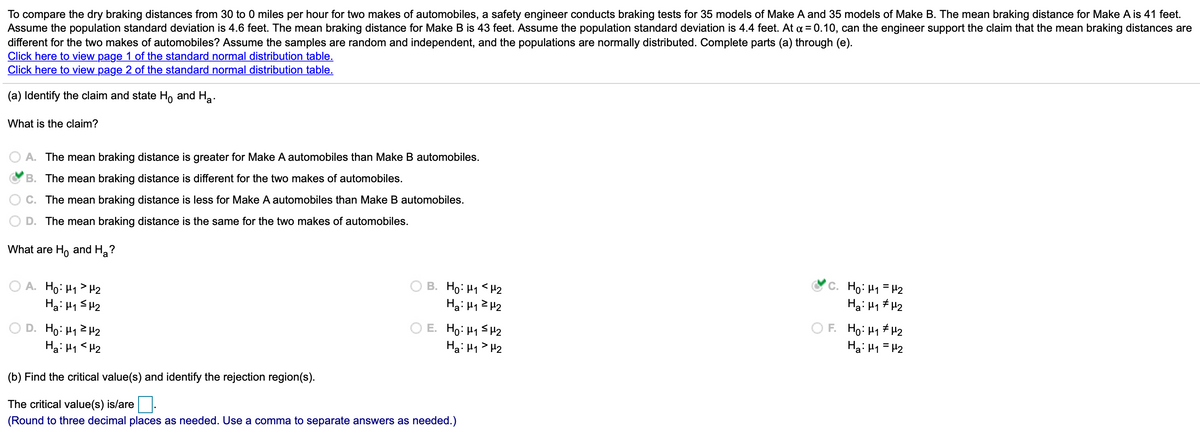To compare the dry braking distances from 30 to 0 miles per hour for two makes of automobiles, a safety engineer conducts braking tests for 35 models of Make A and 35 models of Make B. The mean braking distance for Make A is 41 feet. Assume the population standard deviation is 4.6 feet. The mean braking distance for Make B is 43 feet. Assume the population standard deviation is 4.4 feet. At a = 0.10, can the engineer support the claim that the mean braking distances are different for the two makes of automobiles? Assume the samples are random and independent, and the populations are normally distributed. Complete parts (a) through (e). Click here to view page 1 of the standard normal distribution table. Click here to view page 2 of the standard normal distribution table. (a) Identify the claim and state Ho and H. What is the claim? O A. The mean braking distance is greater for Make A automobiles than Make B automobiles. B. The mean braking distance is different for the two makes of automobiles. O C. The mean braking distance is less for Make A automobiles than Make B automobiles. O D. The mean braking distance is the same for the two makes of automobiles. What are Ho and H? c. Ho: H1=P2 O A. Ho: H1> H2 H:H SH2 O B. Ho: H1
To compare the dry braking distances from 30 to 0 miles per hour for two makes of automobiles, a safety engineer conducts braking tests for 35 models of Make A and 35 models of Make B. The mean braking distance for Make A is 41 feet. Assume the population standard deviation is 4.6 feet. The mean braking distance for Make B is 43 feet. Assume the population standard deviation is 4.4 feet. At a = 0.10, can the engineer support the claim that the mean braking distances are different for the two makes of automobiles? Assume the samples are random and independent, and the populations are normally distributed. Complete parts (a) through (e). Click here to view page 1 of the standard normal distribution table. Click here to view page 2 of the standard normal distribution table. (a) Identify the claim and state Ho and H. What is the claim? O A. The mean braking distance is greater for Make A automobiles than Make B automobiles. B. The mean braking distance is different for the two makes of automobiles. O C. The mean braking distance is less for Make A automobiles than Make B automobiles. O D. The mean braking distance is the same for the two makes of automobiles. What are Ho and H? c. Ho: H1=P2 O A. Ho: H1> H2 H:H SH2 O B. Ho: H1
Glencoe Algebra 1, Student Edition, 9780079039897, 0079039898, 2018
18th Edition
ISBN:9780079039897
Author:Carter
Publisher:Carter
Chapter10: Statistics
Section10.5: Comparing Sets Of Data
Problem 13PPS
Related questions
Question
100%

Transcribed Image Text:To compare the dry braking distances from 30 to 0 miles per hour for two makes of automobiles, a safety engineer conducts braking tests for 35 models of Make A and 35 models of Make B. The mean braking distance for Make A is 41 feet.
Assume the population standard deviation is 4.6 feet. The mean braking distance for Make B is 43 feet. Assume the population standard deviation is 4.4 feet. At a = 0.10, can the engineer support the claim that the mean braking distances are
different for the two makes of automobiles? Assume the samples are random and independent, and the populations are normally distributed. Complete parts (a) through (e).
Click here to view page 1 of the standard normal distribution table.
Click here to view page 2 of the standard normal distribution table.
(a) Identify the claim and state H, and Ha.
What is the claim?
A. The mean braking distance is greater for Make A automobiles than Make B automobiles.
B. The mean braking distance is different for the two makes of automobiles.
C. The mean braking distance is less for Make A automobiles than Make B automobiles.
D. The mean braking distance is the same for the two makes of automobiles.
What are Ho and Ha?
A. Ho: H1> H2
B. Ho: H1 <H2
Hại H1Z H2
'C. Ho: H1 = H2
Ha: H1 # H2
Ha: H1 SH2
D. Ho: H1 2 H2
Ha: H1 < H2
E. Ho: H1 SH2
Ha: H1 > H2
F. Ho: H1 # H2
Ha: H1 = H2
(b) Find the critical value(s) and identify the rejection region(s).
The critical value(s) is/are
(Round to three decimal places as needed. Use a comma to separate answers as needed.)
Expert Solution
This question has been solved!
Explore an expertly crafted, step-by-step solution for a thorough understanding of key concepts.
This is a popular solution!
Trending now
This is a popular solution!
Step by step
Solved in 2 steps with 1 images

Knowledge Booster
Learn more about
Need a deep-dive on the concept behind this application? Look no further. Learn more about this topic, statistics and related others by exploring similar questions and additional content below.Recommended textbooks for you

Glencoe Algebra 1, Student Edition, 9780079039897…
Algebra
ISBN:
9780079039897
Author:
Carter
Publisher:
McGraw Hill

Glencoe Algebra 1, Student Edition, 9780079039897…
Algebra
ISBN:
9780079039897
Author:
Carter
Publisher:
McGraw Hill